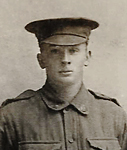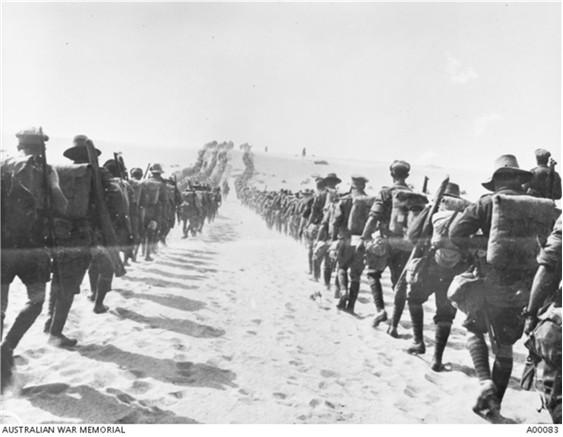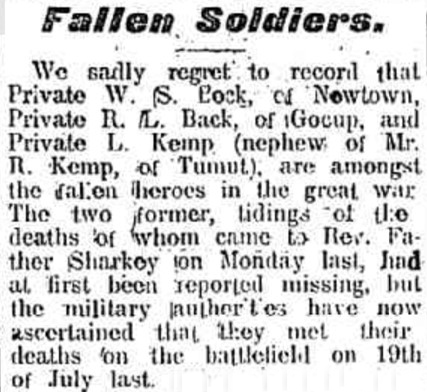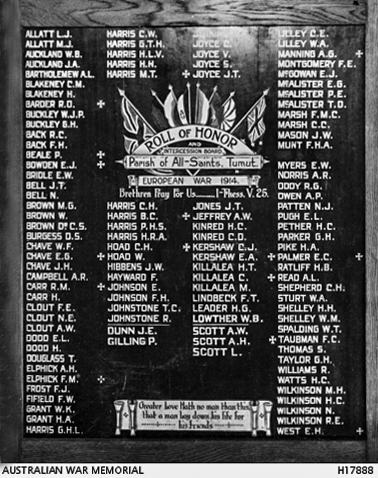Richard Clarence BACK
Eyes light grey, Hair fair, Complexion yellow
Richard Back - From Gocup to Fromelles
Can you help us identify Richard?
Richard was killed in Action at Fromelles. As part of the 53rd Battalion, he was positioned near where the Germans collected soldiers who were later buried at Pheasant Wood. There is a chance he might be identified, but we need help. We are still searching for suitable family DNA donors.
In 2008 a mass grave was found at Fromelles, a grave the Germans dug for 250 (Australian) bodies they recovered after the battle. As of 2024, DNA matching from relatives has enabled the identification of 180 of these soldiers.
If you know anything of contacts for Richard in the Tumut/Gocup area of New South Wales or his relatives from Hythe, Shepway District, Kent, England and Scarriff, Clare, Ireland, please contact the Fromelles Association.
See the DNA box at the end of the story for what we do know about his family.
Early Life
Richard Clarence Back was born in August 1893 in Tumut, New South Wales to Henry Nelson and Frances ‘Fanny’ Amelia (nee Clee) Back. They also had a second son, Alexander, born in 1895. Tumut is a rural area about 100 km west of Canberra. The family lived in nearby Gocup. Richard’s parents were born in Australia but his father’s parents came from Hythe, Kent, England, on the English Channel. Fanny’s parents were from nearby Gunning NSW and Clare, Ireland.
Richard’s and his family went through many challenges. His mother Fanny had first married Francis Gardner, but he passed away a year after they married. Three years later she married Henry Back, a “hardworking, industrious and a devoted husband” However, when Richard was 8 years old, Henry developed lung problems and died.
Further to Henry’s character (above), his obituary also cited that:
“a numerous cortege of friends and sorrowing relatives attended his funeral.”
Fanny married again a few years later, to Willam Watson, and they had twin sons, William and John. Tragedy struck again when Richard was 13, Fanny died of pneumonia/pleurisy. Four young boys from two fathers and now no mother. Richard was working as a labourer when he enlisted and given the situation and where the family lived, it is likely that he would have begun working at or before the time his mother died.
Off to War
In mid-1915 recruiting efforts for the War were well underway across country New South Wales and Richard was among the many from Tumut to join. The Honor Board at the Tumut All Saints Parish alone includes 180 names. He enlisted on 25 July 1915 at Cootamundra, New South Wales and was assigned as a private to the 1st Battalion, 11th Reinforcements with the regimental number 3234. He then went to begin his recruit training at the Liverpool Camp near Sydney.
After a short period of military training, he was headed for Egypt on 5 October 1915, embarking for the two-month-long trip from Sydney, New South Wales on board HMAT A32 Themistocles. Richard’s transport ship arrived at Port Said in Egypt in the first week of January 1916. He and his fellow reinforcements were moved to the training camp at Tel-el-Kebir, which was about 110 km northeast of Cairo. The 40,000 men in the camp were comprised of Gallipoli veterans and the thousands of reinforcements arriving regularly from Australia.
With the ‘doubling of the AIF’ as it expanded from two infantry divisions to five, major reorganisations were underway. On 13 February Richard was transferred to the newly formed 53rd Battalion. The Gallipoli soldiers in the 53rd were not slow in pointing out to whoever would listen that they were the “Dinkums” and the new recruits were the “War Babies”.
Source AWM4 23/70/1, 53rd Battalion War Diaries, Feb-July 1916, page 3
Richard’s regimental number was formally changed to 3234B in April to avoid confusion with at least one other man who had come into the unit with the same number. Regimental numbering was a clumsy and confusing system that was not helped with officers having no number at all. The letters A and B were added where necessary to help identification in service records.
Training for all continued. In March they were sent to Ferry Post, on foot, a trip of about 60 km that took three days. It was a significant challenge, walking over the soft sand in the 38°C heat with each man carrying their own possessions and 120 rounds of ammunition. Many of the men suffered heat stroke.
Once there, they remained at Ferry Post guarding the Suez Canal until 16 June when they began the move to the Western Front. 32 officers and 958 soldiers of the 53rd left Alexandria on 19 June on the troopship Royal George , bound for Marseilles, France to become part of the British Expeditionary Force (BEF) on the Western Front.
They arrived in Marseilles on 28 June and immediately entrained for a 62-hour journey north to Hazebrocuk, before finally marching into the camp at nearby Thiennes. During their trip it was noted that their ‘reputation had evidently preceded them’, as they were well received by the French at the towns all along the route.
Source AWM4 23/70/2 53rd Battalion War Diaries July 1916 page 4
They were headed to the area of Fleurbaix which was known as the “Nursery Sector” – a supposedly relatively quiet area where inexperienced Allied troops could learn the harsh realities of Western Front trench warfare against the Germans. But the quiet times and the training period did not last long.
Fromelles
On 8 July they began a 30 km march to Fleurbaix and were settled into billets there on 16 July.
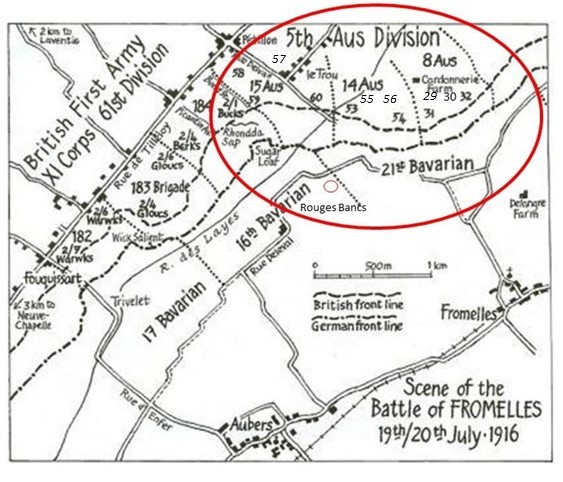
Early the next morning, the 53rd were moved straight into the front lines for an attack, but it was cancelled due to bad weather. They remained in the trenches in relief of the 54th.
On the 19th, heavy bombardment was underway from both armies by 11 AM. At 4 PM the 54th rejoined on their left. All were now in position for battle. The Zero Hour for advancing from their front-line trenches was to be 5.45 PM, but the Germans knew this attack was coming and were well-prepared. They opened a massive artillery bombardment on the Australians at 5.15 PM, causing chaos and many casualties.
The main objective for the 53rd was to take the trenches to the left of a heavily armed, elevated German defensive position, the ‘Sugar Loaf’, which dominated the front lines. If the Sugar Loaf could not be taken, the 53rd and the other battalions would be subjected to murderous enfiladed fire from the machine guns and counterattacks from that direction. As they advanced, they were to link up with the 60th and 54th Battalions on their flanks.
The Australians went on the offensive at 5.43 PM. They moved forward in four waves – half of Richard’s A Company & B Company in each of the first two waves and half of C & D in the third and fourth. They did not immediately charge the German lines, but went out into No-Man’s-Land and lay down, waiting for the British bombardment to lift.
At 6.00 PM the German lines were rushed. The 53rd were under heavy artillery, machine gun and rifle fire, but were able to advance rapidly. Corporal J.T. James of C Company (3550) reported:
“At Fleurbaix on the 19th July we were attacking at 6 p.m. We took three lines of German trenches”
As below, the 14th Brigade War Diary notes that the artillery had been successful and “very few living Germans were found in the first and second line trenches”, but within the first 20 minutes the 53rd lost ALL the company commanders, ALL their seconds in command and six junior officers.
Source AWM C E W Bean, The AIF in France, Vol 3, Chapter XII, pg 369
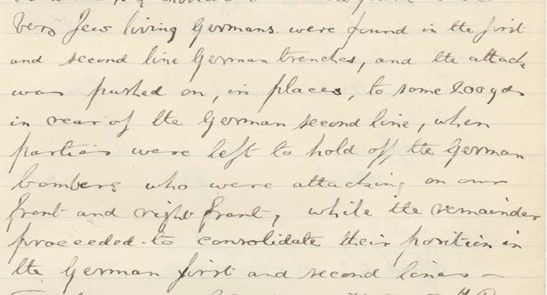
Some of the advanced trenches were just water filled ditches, which needed to be fortified by the 53rd to be able to hold their advanced position against future attacks. They were able to link up with the 54th on their left and, with the 31st and 32nd, occupy a line from Rouges Bancs to near Delangre Farm. However, the 60th on their right had been unable to advance due to the devastation from the machine gun emplacement at the Sugar Loaf.
They held their lines through the night against “violent” attacks from the Germans from the front, but their exposed right flank had allowed the Germans access to the first line trench BEHIND the 53rd, requiring the Australians to later have to fight their way back to their own lines. By 9.00 AM on the 20th, the 53rd received orders to retreat from positions won and by 9.30 AM they had “retired with very heavy loss”.
Source AWM4 23/70/2 53rd Battalion War Diaries July 1916 page 7
Of the 990 men who had left Alexandria just weeks before, the initial count at roll call was 36 killed, 353 wounded and 236 missing, including Richard. “Many heroic actions were performed.”
Source AWM4 23/70/2 53rd Battalion War Diaries July 1916 page 8
To get some perspective of the battle, when Charles Bean, Australia’s official war historian, attended the battlefield two and half years later, he observed a large amount of bones, torn uniforms and Australian kit still on the battlefield.
The final impact of the battle on the 53rd was that 245 soldiers were killed or died from their wounds and, of this, 190 were not able to be identified.
After the Battle
There are no detailed reports about what happened to Richard, whether he was killed in the early or later stages of the battle. News that Richard was missing was reported in the local papers by early September. After the battle, the Army did undertake extensive searches for the missing, including communications with the Germans. However, it took until 2 September 1917 before a Formal Enquiry in the Field was held that declared Richard as having been Killed in Action.
He has no known grave.
Richard was awarded the 1914-15 Star, the British War Medal, the Victory Medal a Memorial Scroll and a Memorial Plaque.
He is commemorated at:
- V.C. Corner Australian Cemetery Memoria Panel 7, Fromelles,
- the Tumut and District Soldiers' Honor Board
- and on the Parish of All Saint's Roll of Honor in Tumut.
At the unveiling of the Tumut and District Honour Board, Tumut’s federal representative, Mr. Robert Patten said:
“No greater effort could be blazoned on any scroll than that they died that we might be left in safety, and that the liberty we know and treasure should, not be trampled in the mud.”
Could Richard Still Be Found?
In 2008 a mass grave dug by the Germans was discovered that contained 250 bodies. As of 2024, DNA matching from family members has enabled 180 of these soldiers to be identified, including 15 of the 190 unidentified soldiers from the 53rd. Richard may have been fighting in the area where his mates were found.
If you know anything of contacts for Richard in the Tumut/Gocup area of New South Wales or his relatives from Hythe, Shepway District, Kent, England and Scarriff, Clare, Ireland, please contact the Fromelles Association.
Family connections are sought for the following soldier
| Soldier | Richard Clarence Back (1893-1916) |
| Parents | Henry Nelson Back (1865-1901) b Tumut d Gocup NSW and Frances Amelia Clee 1873-1906) b Tumut NSW d Gocup NSW, also married Francis Garner and William Watson |
| Siblings | Alexander Archibald Back (1895-1965) b Tumut NSW d Tumut NSW m Myra Jagoe | ||
| Half-Sibling Willim Stephen Watson (1905-1965 b Tumut NSW d Yass NSW m Agnes Wheeler | |||
| Half-Sibling John Archibald Watson (1905-1967) b Tumut NSW d Cowra Shire NSW m Gladys Goodger |
| Grandparents | |||
| Paternal | Wiliam (1822-1901) b Hythe, Shepway District, Kent, England d Tumut NSW and Susannah Stockwell (1826-1921) b Hythe, Shepway District, Kent, England d Tumut NSW | ||
| Maternal | Richard Clee (1840-1926) b Gunning, NSW d Gocup NSW and Margaret MacNamara (1835-1913) b Scarriff, Clare, Ireland d Tumut NSW |
The Fromelles Association would love to hear from you

Contacts
(Contact: carla@fromelles.info or geoffrey@fromelles.info).
(Contact: army.uwc@defence.gov.au or phone 1800 019 090).
Donations
If you are able, please contribute to the upkeep of this resource.
(Contact: bill@fromelles.info ).
